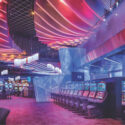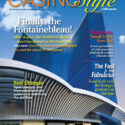
The term “integrated resort” was coined to describe Singapore’s massive casino complexes, rival properties with gaming and non-gaming attractions on a mind-boggling scale.
Marina Bay Sands is known for its Skypark Observation Deck, Banyan Tree spa, sampan rides, ArtScience Museum with 21 galleries, 20-plus restaurants and the world’s largest infinity pool. Resorts World Sentosa, too, has a dizzying array of attractions: Universal Studios Singapore, Dolphin Island, the Adventure Cove Waterpark—even its own tall ship, the Royal Albatross. The amenities attract gamblers and non-gamblers, tourists and locals, the young and not-so-young, even families with children.
Against these standards, a casino alone may no longer seem enough—which presents a challenge for operators who want to offer a more complete experience, sometimes with limited space or a modest budget.
“Large-scale integrated resorts have raised the bar in terms of guest expectations, and people take those expectations with them wherever they go,” acknowledges Jeanne Muscolino, principal and business development manager for JCJ Architecture. But casinos in Kansas and Mississippi can’t grow up to be the megaresorts of Las Vegas, Malaysia and Singapore. Nor should they try.
“Every property is unique in its own right, in its own marketplace and in the type of guests it attracts,” Muscolino says. “Operators and owners have matured in terms of how they think about programming their space and their square footage, and are better at knowing their customer. In terms of design, that helps us really respond to the needs of the marketplace.”
The impact of new additions may be especially meaningful in smaller markets, says Doug Worth, executive chairman and principal designer of WorthGroup Architecture. “Normally, everybody’s trying to one-up each other on how spectacular their projects are. We specialize on the tribal side of gaming, and in the early days, they didn’t have all the money in the world. Everything was a value judgment on what it would contribute to the casino business,” which is still the engine of most gaming properties.
Gut-driven, trend-influenced decisions have given way to hard data, marketing insights and feasibility analyses. With those facts in mind, consider new additions that will extract more value from current patrons, and also lure new ones.
Eat Up
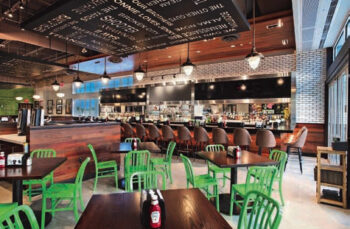
Wahlburger’s is a familiar brand with name value enhanced by a reality TV series.
The addition of new food and beverage options goes “a really long way” to keeping customers around, says Muscolino. “They’re not loss-leaders for properties anymore, but can be destinations on their own.”
The right three-meal service offering with a well-known brand can turn a pub or bar into an entertainment hub. Case in point: the Rock & Brews chain, established by KISS co-founders Gene Simmons and Paul Stanley. With 20-plus restaurants across the U.S. and more to come, the brand blends a rock ‘n’ roll theme, American-style comfort food and craft beers. There’s even a Rock & Brews Casino in Braman, Oklahoma, operated by the Kaw Nation of Indians.
In 2021, JCJ designed a Rock & Brews for the Rolling Hills Casino in Corning, California, owned by the Paskenta Band of Nomlaki Indians. The advantages are many, says Muscolino.
“Those guys offer a really brilliant product; it doesn’t take up a ton of space, and it draws a lot of traffic. So folks might go to a casino really to experience the restaurant, then do some gaming on the side.”
A new TAO Asian bistro at Mohegan Sun in Connecticut has drawn four- and five-star raves, like this one on TripAdvisor: “First, the design elements are on a Disney scale… When your table is ready, make the journey through this ‘water’ hallway into the expansive dining room. This is a wow—there is so much to look at!”
A restaurant alone doesn’t elevate a property to resort status, but it’s “not just a slot house anymore,” says Worth. “A popular trend in a lot of our tribal casinos is the Wahlburger’s franchise,” co-founded by actors Mark and Donnie Wahlburg.
“We’re doing three of them right now in different locations. It’s still a hamburger joint, but they’ve got a TV show and some recognition, and people come here for that. It’s an easy go-to addition to an existing facility that was never planned to be much more than a casino.”
And of course the Gordon Ramsay and Guy Fieri brands are familiar to casino-goers around the world.
Staying Power
With food and beverage in place, a hotel may be the logical next step. “Most of the properties we work on aren’t in an urban area, but are hard to get to—three- or four-hour trips, flying or driving,” says Worth.
That’s no one’s idea of a day trip, and potential customers could stay away altogether rather than undertake a round-trip long haul. Overnight accommodations don’t have to break the bank, but come in several forms, including RV parks and limited-service hotels, Worth adds. “You can accomplish a lot on a fairly small footprint and with a limited budget.”
“Even a smaller 100-key hotel can make a big difference,” agrees Muscolino. “Then you’re measuring length of stay by days as opposed to hours. It helps not only generate revenue on the gaming floor, but across amenities.”
Multitasking
If demands exists, set aside space for meetings and conventions—then use it for other purposes, such as live entertainment.
“Budget-wise, you don’t really have to do a whole lot” to monetize these areas, says Worth. “Some smaller operators do very well, bringing in entertainers who draw a regional crowd, then using the same space for special events, tournaments, and conferences and meetings. In some cases, it’s a differentiator that makes them stand out from the competition.”
Food-and-beverage areas can multitask too. “A full-service sports bar can double as your sportsbook and also have food service throughout the day,” observes Muscolino. “Then you can tack on entertainment. You’ll even see little areas within sportsbooks that are dedicated to broadcast media, who broadcast live on game day. It creates this really energized environment, with these semi-celebrities on-property. That’s really attractive to customers.”
The goal, as always, is to keep guests onsite and at play, she says. “How can you take an area and make sure that it’s monetizable throughout the day? Like the sportsbook that’s doing double duty, there might be a way to activate a kitchen so it’s providing grab-and-go breakfast and cafe service,” and drawing people at all hours—important in a 24/7 enterprise.
Derek Stevens brought an innovative version of the all-purpose sportsbook to the new Circa Resort & Casino in Downtown Las Vegas, which opened in October 2020. Stadium Swim is a 4,000-capacity sports bar and pool club with a big screen—make that a monster screen, at 40 feet by 143 feet—to broadcast the latest games. Guests can watch while lolling in one of six heated pools, then swim up to their favorite bar and share the experience with their friends at one of the club’s “Insta-ready selfie walls.”
Risky Business
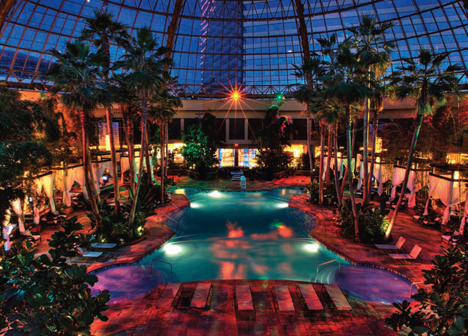 It’s tricky to make a nightclub work outside an urban market, and even big-city resorts can miss the mark. Take the Palms in Las Vegas, which added an indoor-outdoor nightclub as part of the property’s $640 million overhaul, completed in 2019.
It’s tricky to make a nightclub work outside an urban market, and even big-city resorts can miss the mark. Take the Palms in Las Vegas, which added an indoor-outdoor nightclub as part of the property’s $640 million overhaul, completed in 2019.
The aptly named KAOS opened and closed within seven months. At the time, Red Rock Resorts boss Frank Fertitta III blamed the high cost of business, in particular, paying headliner DJs like Marshmello. As a scathing post-mortem in the Las Vegas Review-Journal noted, “No responsible operator would be willing to pay a DJ $60 million over two years, or $600,000 per show, even if that individual wore a flashy, LED-equipped bucket on his head.”
After the club went dark, the Palms decided to take some time to reassess the programming, and used the space for pool operations, private meeting space and special events. In 2021, Red Rock and Station Casinos sold the Palms to the San Manuel Band of Mission Indians of California, making it the first tribe to own and operate a resort in Las Vegas.
That misstep aside, resorts in Vegas and other markets have shown that a great watering hole can serve as a successful day club, nightclub, food venue, party spot and revenue stream. Harrah’s Pool in Atlantic City is one example. With two waterfalls, three hot tubs, eight cabanas and three fire pits, it offers night and day programming that’s really paid off for its parent, and earned it a place on USA Today’s list of the “10 Best Resort Pools in America.”
Replicate the cool pool experience on a smaller scale, without the giant price tag, and just like that, you’re attracting and serving a younger clientele. They just may become your next generation of casino regulars.
Inside/Out
The Covid-19 pandemic forced businesses to appreciate spaces they may have previously overlooked—right outside their doors.
Even in big cities with four-season climes, restaurants and resorts stayed afloat by moving service outdoors, onto sidewalks and into parks, under sailcloth tents and in heated domes. Fire pits and torches added a level of ambience that hasn’t gone out of style.
“You can take a bar cart out on a patio and voila, you’ve got something you can monetize,” says Muscolino. “It’s not so hard to take an underutilized patio area, dress up the landscaping, perhaps add some decorative lighting and turn it into a pre-function space. You can hold small events out there.”
The same principles apply inside the gaming hall, where daylight and windows are now not only permissible but welcome. Those vistas connect patrons to the great outdoors, and make any space feel lighter and brighter.
“If you’ve got the views; capitalize on them,” says Muscolino.
High ceilings add a feeling of spaciousness and are vital on the casino floor, where gaming machines are getting bigger and bigger. They also make hotel rooms look and feel bigger and more luxurious.
During the pandemic, as properties slowly resumed business, the need for social distancing motivated operators to identify underutilized spaces, such as conference rooms and event space, and turn them into profit centers. As John Hinton, director of Native American projects for Bergman Walls Associates, told Tribal Government Gaming magazine in 2021, “This has our clients thinking about how they can make spaces more flexible and scalable in the future.”
Bring the Family
If you’re thinking about a phased development to reach a wider market, movie theaters and arcades are proven family attractions.
A smaller pool, KidsQuest or similar amenity “can make a lot of sense if you’re trying to get families to stay on-property without giving up a lot of square footage,” according to Muscolino. There are KidsQuest locations at scores of casinos in Nevada, Louisiana, Washington state, California, Michigan and elsewhere. One big advantage: they offer drop-in child care, so Mom and Dad can enjoy adulting, on and off the gaming floor.
But first things first—know your current customers, know who you want your future customers to be, and with data and market assessments, determine the kinds of additions that will keep them coming.
Anatomy of an Upgrade
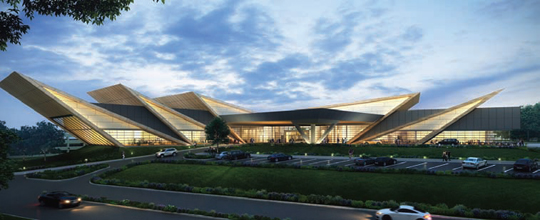
Bally’s Kansas City has undergone a complete transformation since its acquisition by Bally’s Corp. in 2020. The stationary riverboat, located on 24 waterfront acres, opened in 1996 as the Hilton Flamingo Casino, became the Isle of Capri in 2001, and was acquired by Eldorado Resorts in 2017 before being sold to Twin River Holdings, later Bally’s.
The new owners started by rezoning the site to “unlock the potential of the land.” The property has already added a baccarat lounge and a high-limit gaming area and improved the entryways, lighting and parking areas. It is also building a 38,000-square-foot land-based commercial building to house a Chickie’s & Pete’s Crabhouse and Sports Bar and Sugar Factory. A hotel is also in the master plan, along with a retail sector and possible amphitheater.
The $40 million renovation is a project of Whiting Turner Contracting.
Keeping It Fresh
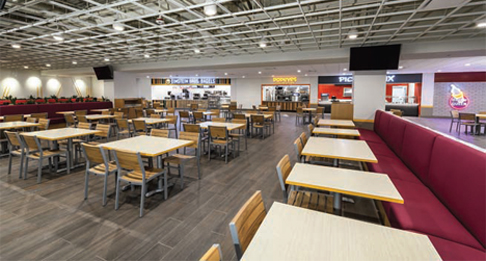 Older resorts with all the bells and whistles need periodic upgrades to keep patrons interested.
Older resorts with all the bells and whistles need periodic upgrades to keep patrons interested.
Such was the case at Circus Circus in Las Vegas, which opened in 1968. The property opened without a hotel, but made up for it in short order, adding a 15-story tower in 1972, an adjoining tower and convention hall in 1975, an RV park and motor lodge, and more. Other amenities include a wedding chapel and retail district.
The latest addition is a Big Top Food Court that opened in October 2021, just in time for the multi-day Electric Daisy Carnival, which brings hundreds of thousands of partiers to Las Vegas each year.
Architectural firm Bergman Walls & Associates achieved an open floor plan by removing a section of a hotel tower shear wall. The upgrade turned parts of the existing buffet, baggage claim and retail spaces into a 16,000-square-foot food court offering multiple fast-casual options.
Two administrative offices and more back-of-house space were part of the build-out, for an addition that has brought more than 80 new jobs to the Strip casino, new options for hungry patrons, and increased opportunities for revenue.




